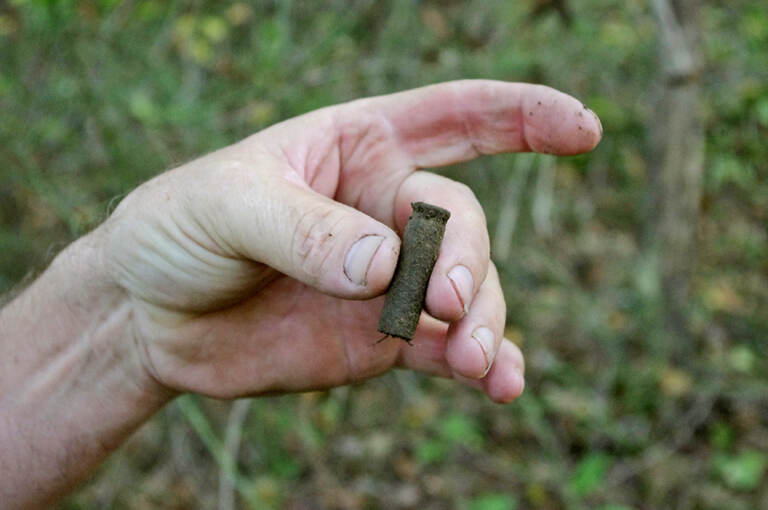The Memory of Land
Listen 49:17
In this Thursday Sept. 25, 2014 photo, Kenny King, 59, of Ethel, W.Va., displays a shell casing dating back to World War I on the grounds of Blair Mountain, W.Va. The Battle of Blair Mountain, a five-day skirmish between law enforcement and union miners in the coalfields of southern West Virginia, occurred here. Environmental groups, including the Sierra Club, have joined King in petitioning the National Register of Historic Places to declare Blair Mountain a historic landmark. (AP Photo/Matt Stroud)
Living on a planet that’s been inhabited by humans for hundreds of thousands of years means pretty much every piece of ground that you walk on holds some history. Somebody was born right here, somebody died, somebody got married, gave a speech, or ran a store. Maybe a famous battle was fought on this spot. Maybe the piece of grass you call your lawn was once sacred ground.
Over time, left alone, the structures and belongings of those who came before us return to the ground, becoming layers of dust and dirt. In some places, we choose to preserve that history, and the land that holds it — in others, the physical past is razed to the ground, and exists only in human memories.
Either way, being in those places can be a powerful experience — an anchor for our memories, and how we remember what happened.
On today’s episode we look at the connection between place and memory and why they’re so deeply linked. We hear stories about a mountain in West Virginia that was the site of a bloody battle between coal miners and mine owners — and the ongoing fight over how that history should be remembered. We take a tour of an area that used to be known as Black Bottom, a largely African-American neighborhood in Philadelphia that was razed in the name of development. And we talk to scientists about how memories exist in our brains, and why they’re so deeply tied to place.
Also heard on this week’s episode:
- Over the past 20 years, journalist Tim Lambert has watched as the land his family once owned in Western Pennsylvania transformed from tranquil farmland to the horrific crash site of Flight 93, to a national memorial. He joins us to discuss the connection between the land and the memory of Flight 93. Lambert and NPR reporter Scott Detrow have produced an audio documentary for the 20th anniversary of 9/11 called “Sacred Ground.”
- The neighborhood where 71-year-old Andre Black grew up was a tight-knit community of working-class Black families. Then, in the 1960s, the city of Philadelphia claimed the area for “urban renewal,” forcibly relocating 5,000 of its residents. Reporter Sojourner Ahébée follows Black on a tour of the neighborhood once known as Black Bottom — that now exists only in memory.
- We talk with Adam Osth, a lecturer at the University of Melbourne who studies theories of memory formation, about how and why places are so closely tied to memories.
- In 2017, developers were excavating a site for a new condo project in Philadelphia when they came across the remains of hundreds of people — a forgotten burial ground from the colonial era. Reporter Elana Gordon followed two archaeologists on their mission to rescue those remains for the sake of history and science.
Segments from this episode
WHYY is your source for fact-based, in-depth journalism and information. As a nonprofit organization, we rely on financial support from readers like you. Please give today.






